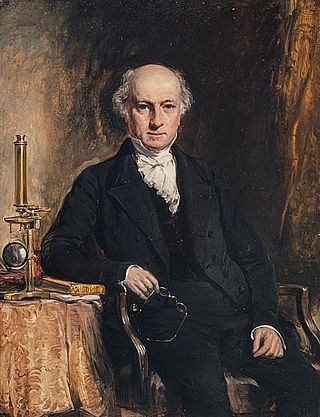Related Research Articles

George Chalmers was a Scottish antiquarian and political writer.

William Cullen was a Scottish physician, chemist and agriculturalist, and professor at the Edinburgh Medical School. Cullen was a central figure in the Scottish Enlightenment: He was David Hume's physician, and was friends with Joseph Black, Henry Home, Adam Ferguson, John Millar, and Adam Smith, among others.

George Combe was a Scottish lawyer and a spokesman of the phrenological movement for over 20 years. He founded the Edinburgh Phrenological Society in 1820 and wrote The Constitution of Man (1828). After marriage in 1833, Combe devoted his later years to promoting phrenology internationally.

Colonel Sir John Sinclair, 1st Baronet,, was a Scottish politician, military officer, planter and writer who was one of the first people to use the word "statistics" in the English language in his pioneering work, Statistical Accounts of Scotland, which was published in 21 volumes.

Alexander Monro was a Scottish surgeon and anatomist. His father, the surgeon John Monro, had been a prime mover in the foundation of the Edinburgh Medical School and had arranged Alexander's education in the hope that his son might become the first Professor of Anatomy in the new university medical school.
Prof John Lizars FRSE was a Scottish surgeon, anatomist and medical author.

George Johnston was a Scottish physician and naturalist.

Alexander Monro of Craiglockhart and Cockburn was a Scottish anatomist, physician and medical educator. He is typically known as Alexander Monro Secundus to distinguish him as the second of three generations of physicians of the same name. His students included the naval physician and abolitionist Thomas Trotter. Monro was from the distinguished Monro of Auchenbowie family. His major achievements included, describing the lymphatic system, providing the most detailed elucidation of the musculo-skeletal system to date and introducing clinical medicine into the curriculum. He is known for the Monro–Kellie doctrine on intracranial pressure, a hypothesis developed by Monro and his former pupil George Kellie, who worked as a surgeon in the port of Leith.
John Anderson was a Scottish surgeon and genealogist, of Hamilton, Lanarkshire.

John Barclay was a Scottish comparative anatomist, extramural teacher in anatomy, and director of the Highland Society of Scotland.

Sir George Ballingall was a Scottish physician and surgeon. He was regius professor of military surgery at the University of Edinburgh.

Robert Jackson M.D. (1750–1827) was a Scottish physician-surgeon, reformer, and inspector-general of army hospitals.

Andrew Duncan, the elder FRSE FRCPE FSA (Scot) was a British physician and professor at the University of Edinburgh. He was joint founder of the Royal Society of Edinburgh. As first proposer of an asylum in Edinburgh he gives his name to the Andrew Duncan Clinic which forms part of the Edinburgh City Hospital.
Events from the year 1846 in Scotland.

Hugh Murray FRSE FRGS (1779–1846) was a Scottish geographer and author. He is often referred to as Hew Murray.
Events from the year 1726 in Scotland.
Alexander Leighton (1800–1874) was a Scottish writer, known as the editor of Tales of the Borders.
Events from the year 1728 in Scotland.
Events from the year 1729 in Scotland.

Robert Nasmyth FRCSEd, FRSE was a Scottish dental surgeon from Edinburgh who was Surgeon-Dentist to Queen Victoria in Scotland. He was President of the Odonto-Chirurgical Society of Scotland and was one of the founders of the Edinburgh Dental Dispensary, which would evolve into the Edinburgh Dental Hospital and School.
References
![]() This article incorporates text from a publication now in the public domain : Chichester, Henry Manners (1889). "Fuller, John (d.1825)". In Stephen, Leslie (ed.). Dictionary of National Biography . Vol. 20. London: Smith, Elder & Co.
This article incorporates text from a publication now in the public domain : Chichester, Henry Manners (1889). "Fuller, John (d.1825)". In Stephen, Leslie (ed.). Dictionary of National Biography . Vol. 20. London: Smith, Elder & Co.